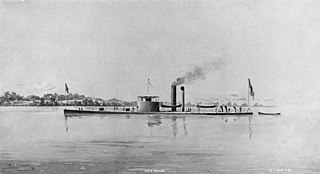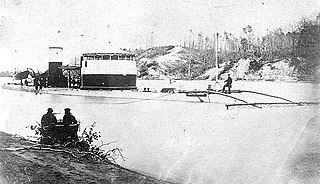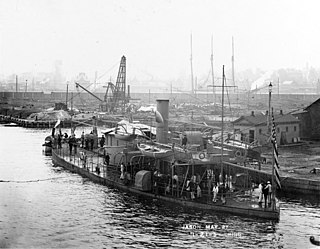See also
- Canonicus-classmonitor, a class of nine ships built for the Union Navy during the American Civil War
Four ships of the United States Navy have been named Canonicus for Canonicus, a chief of the Narragansett Indians, who befriended Roger Williams, and presented him with a large tract of land for the Rhode Island colony.
Four ships of the United States Navy have borne the name USS Tecumseh, in honor of Tecumseh, a Shawnee Indian chief.
Eight ships of the United States Navy and United States Revenue Cutter Service have been named USS Massachusetts, after the Commonwealth of Massachusetts.
USS Vesuvius may refer to:
TCG Mauvenet may refer to one of the following ships of the Turkish Navy:
Three vessels of the United States Navy have been named USS San Francisco, after the city of San Francisco, California.
The first USS Nantucket was a Passaic-class coastal monitor in the United States Navy.

USS Canonicus was a single-turret monitor built for the United States Navy during the American Civil War, the lead ship of her class. The ship spent most of her first year in service stationed up the James River, where she could support operations against Richmond and defend against a sortie by the Confederate ironclads of the James River Squadron. She engaged Confederate artillery batteries during the year and later participated in both attacks on Fort Fisher, defending the approaches to Wilmington, North Carolina, from December 1864 to January 1865.
Canonicus (ACM-12) was a Camanche-class auxiliary minelayer in the United States Navy. It was named for Canonicus, a chief of the Narragansett Indians.

The first Passaic was a single turreted, coastal monitor purchased by the United States Navy for service during the American Civil War.
Four ships in the United States Navy have been named USS Gwin for William Gwin.

USS Saugus was a single-turreted Canonicus-class monitor built for the Union Navy during the American Civil War. The vessel was assigned to the James River Flotilla of the North Atlantic Blockading Squadron upon completion in April 1864. The ship spent most of her time stationed up the James River where she could support operations against Richmond and defend against a sortie by the Confederate ironclads of the James River Squadron. She engaged Confederate artillery batteries during the year and later participated in both attacks on Fort Fisher, defending the approaches to Wilmington, North Carolina, in December 1864–January 1865. Saugus returned to the James River after the capture of Fort Fisher and remained there until Richmond, Virginia was occupied in early April.
USS Terror may refer to:

USS Sangamon was a Passaic-class ironclad monitor constructed for the Union Navy during the second year of the American Civil War where she operated in the waterways of the Confederate States of America. She was later recommissioned and placed into service during the Spanish–American War.

USS Catskill (1862) was a monitor built for the United States Navy during the American Civil War. She continued to serve the Navy after the war's end until decommissioned in 1898 after the end of the Spanish–American War.

The Canonicus-class monitor was a class of nine monitors built for the Union Navy during the American Civil War. They saw service in the Civil War and the Spanish–American War, although two of them were never commissioned.
USS Wyandotte is a name used for two ships of the United States Navy:
Three ships of the United States Navy have been named Saugus:
USS Tippecanoe may refer to:
Canonicus was a Native American chief of the Narragansett.

The second USS Canonicus was the Southern Pacific freighter El Cid temporarily converted for planting the World War I North Sea Mine Barrage. Newport News Shipbuilding and Dry Dock Company launched El Cid at Newport News, Virginia on 7 October 1899 for service between New York City and Gulf of Mexico seaports of New Orleans and Galveston, Texas. The United States Shipping Board took control of the ship from Southern Pacific Steamship Company in 1917.